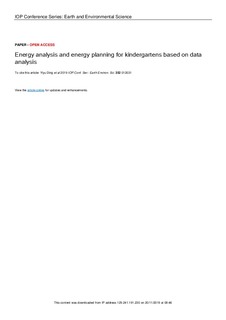| dc.description.abstract | The aim of the study was to utilize different building data for prediction of development in energy use of a typical building type. In this study, energy use and its future development for kindergartens in Trondheim, Norway, were analyzed. The energy use data were retrieved from the energy monitoring platform of Trondheim Municipality. The total area of all the kindergartens was about 76 000 m2, where the area of each kindergarten was ranging from 100 – 4 471 m2. Firstly, typical heat and electricity duration curves per m2 of kindergartens in Trondheim within six years were identified. Secondly, the kindergartens were divided into two cohorts based on their connection to district heating (DH). The average total annual energy use was 177 kWh/m2 for kindergartens without DH, and 168 kWh/m2 for kindergartens connected to DH. The peak load values were similar for both cohorts, about 140 W/m2. Analysis of the duration curves showed a bigger electricity load variation for the kindergartens without DH connection. Within the building cohort with DH, three cases were found depending on the energy share from DH; i.e. DH high share, DH average share, and DH low share. By following different background data for CO2 factors of electricity and local DH, the kindergarten with DH high share had almost the lowest annual CO2 emission. Contrarily, the annual CO2 emission of a kindergarten with lower share of DH, or without DH, usually had a wider range of emissions due to its dependence of the electricity production mix. Finally, a prediction was made by assuming 14.2 % growth rate of kindergartens on the ground of the average six-year total kindergarten area. The result showed that if more than 50-67 % of the new building area would be connected to DH, a smaller increase of CO2 emission from the projected area could be achieved, depending on the relevant CO2 factors. This proved that buildings with DH were more robust than the one without DH concerning CO2 emission. The suggested analysis method and identified duration curves could be used to as a reference example for defining energy profiles of other building types. These profiles are necessary for diversifying and upgrading local energy supply pathways, infrastructure sizing, and improving urban energy planning. | nb_NO |

